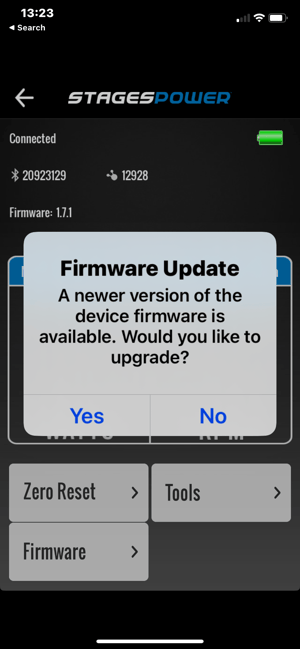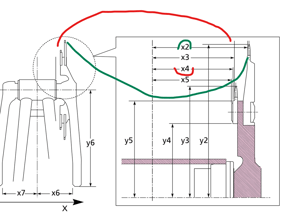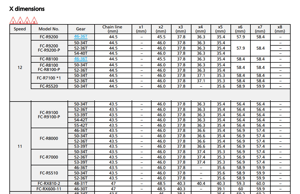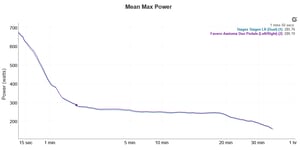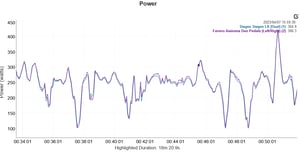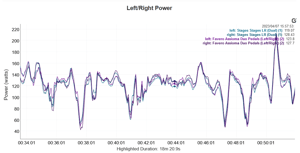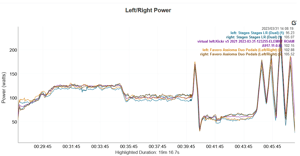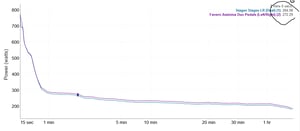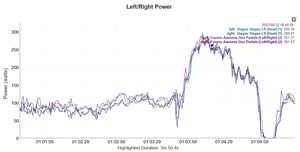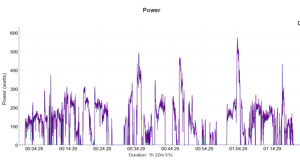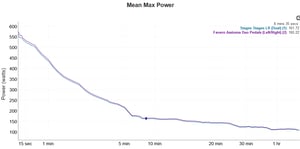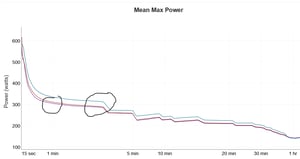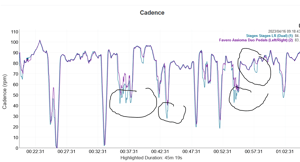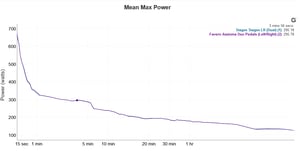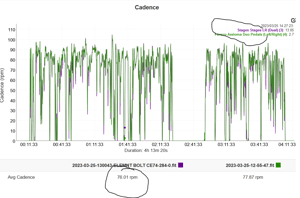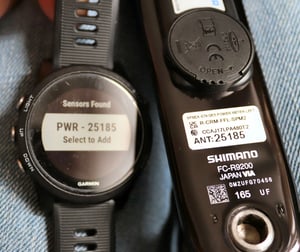 Stages Power Meter Review Gen 3 – on a 12-Speed Shimano Dura-Ace R9200
Stages Power Meter Review Gen 3 – on a 12-Speed Shimano Dura-Ace R9200
I reviewed the latest Stages power meter technology when it launched back in 2020. That particular review was based on Stages’ Gen 3 technology, factory-installed on an 11-speed Shimano Ultegra crankset. This time around, I’m looking at the same Gen 3 technology, but pre-installed and supplied by Stages on a 12-speed R9200 Dura-Ace crankset.
I wanted to examine a few things here. Firstly, I looked at the accuracy of the power meter on the latest firmware and how well it performs on the new generation of Shimano 12-speed cranks. Shimano’s own power meter, the R9200p (12-speed), has faced accuracy issues that could be related to either the forging of the crankset or the electronics themselves. Do Stages power meters face the same accuracy issues linked to the forging? After all, it’s the same crank, albeit with the power meter attached in a different way.
Intended Audience: Newbie to Intermediate
I was intrigued by all of this. Other reviewers have found problems with the R9100p and R9200p, but I’ve only ever used Shimano’s R9100p, which was accurate.
Next, I took a risk and used the 12-speed Dura-Ace crankset on my otherwise 11-speed setup. You might think this should be okay (it was), but there could be subtle left-to-right positional differences and Q-factor differences. I heard that an 11-speed front derailleur might not be able to be adjusted sufficiently far enough to accommodate the required limit setting on a 12-speed. I’ll cover that as well.
Also, my chain was worn out, so I tried a 12-speed chain assuming it would work on my 11-speed cassette (it did). Since I couldn’t find an Ultegra chain, I re-mortgaged my house and bought a Dura Ace 12s chain. Ouch.
Bottom Line
The takeaway is that everything works fine, and I’m happy, albeit a bit poorer.
There appear to be a few idiosyncrasies with the Stages gyroscope-enabled power meter and its accuracy compared to the Assioma, but there’s nothing to overly worry about once the power meter is calibrated.
Leading reviewers have given excellent reviews of Stages’ power meters, and top cyclists use them.
⭐⭐⭐⭐ A great power meter crankset
-
Price
-
Apparent Accuracy
-
Build Quality & Design
-
Features, Including App
-
Openness & Compatability
Summary: A proven power meter that seems fine on Shimano's latest, top-end cranks.
Stages, 4iiii, Garmin, Favero, Wahoo, and SRAM are among the list of well-respected and proven power meter makers. Stages and 4iiii offer third-party power meter options for those who want a Shimano crank-based solution.
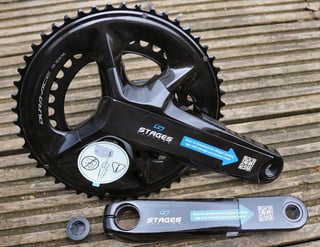
Installation and usage of Stages dual-sided power meter is unremarkable in the sense that “it just works how it should.” Besides the usual pre-ride calibration, all you have to do is watch the power numbers on a head unit of your choice from any manufacturer.
Stages Gen 3 power meter technology is a few years old now, widely used, and known to be good. However, with this one crankset, I seem to experience occasional unexpected readings on the left side. I didn’t detect any issues relating to the right side, whose Hollowtech forged construction is thought to impact right-side power on Shimano R9200p.
Pros
- Widely proven solution
- Good range of Shimano crank length options
- Left-only 105/Ultegra is a more cost-effective intro into power
Cons
- Check left side frame clearance and BB compatibility
- A full LR Dura-Ace crankset is far from cheap. You only need Ultegra.
Installation & Setup
Changing a crankset is straightforward if you know how, but it can be daunting if you’ve never done it before. Assuming you have basic tools, you should only need a special Shimano crank tool to finish off the installation of the new crank. I borrowed one, and it’s simply a plastic circle that tightens the single crank arm inwards.
Shimano Crank Tool: on Amazon
However, I had the further complication of removing the R9100P, which requires a tool specific to that exact model of crank. I had to buy one because it seemed impossible to get the crank off even with some imaginative thinking.
Shimano FC-R9100-P TL-FC40 Tool: on Amazon
I used an old chain tool to remove some links from the DuraAce chain, which was a tad tricky because I came very close to bending part of the new chain. I assume that the DuraAce 12s chain is thinner and hence more prone to this? However, I had a cheap chain tool, and the stops on it may not have been the correct size for the width of the 12s chain.

Re-Assembly
A little bit of grease on the BB bearings and everything was lubed to perfection. I did the whole job on a bike stand as I anticipated needing to make front derailleur adjustments, but all was fine. It might need a half mm or so tweaking to be absolutely perfect, but it’s certainly fine as is. Installing this new crankset is a 10-minute job that might take an hour if you procrastinate and faff about.
The Stages Power app (not the Stages cycling app) is the one you need to install just to check if you have the latest firmware.
You can have a quick spin and open the app to check if cadence and power are reporting (they will be). But it’s also worth checking if your left and right cranks are linked. They should be linked together, and then you only ever pair the left crank ANT+ ID to your bike computer. Indeed, you should only be able to see the left crank’s ANT+ ID.
The final thing to check is the gyroscope. Enabling the gyroscope will use more power, but it might give you more accurate cadence reporting, especially on bumpier surfaces. What? You say you don’t need cadence. And that might be true; however, the power meter DOES need cadence to work out power. It’s a fundamental input, and if, for whatever reason, your PM misses some revolutions, it WILL affect the power.
Techy Corner – What’s compatible with what? Shimano 12s on 11s
Some of this section has been produced with the much-appreciated help of Terry at Better Shifting. He’s the expert on Di2, the rest of us know a fair amount about Di2 but ask him about the bits we don’t!
The 12s crankset is just one component of the 12-speed groupset and does not take into account the implications of 12-speed Di2 or 12-speed rear shifting. These components are almost entirely backwards incompatible, meaning that upgrading to 12-speed will require replacing a significant portion of your bike’s drivetrain components.
Adjusting the front 11s derailleur?
These two diagrams show that the X2 and X4 dimensions represent the distance of each chainring from the bottom bracket. For my old R9100p crankset and my new R9200 crankset, this distance is identical. So there is no need to adjust the front 11s derailleur. The 11s derailleur correctly shifts 12s as it is.
12s Chain Compatability with 11s cassettes and 11s rings
Yes, the 12s chain is backwards compatible to 11s and 10s.
My 11s cassette was coincidentally almost brand new, so there would be no unusual wear to deal with as the 12s chain beds in.
12s Chain ring compatibility with 11s crankset
The Stages PM came with two 12s chainrings which will obviously last me a considerable time. But I have some unused 11s rings lying around. Are they compatible? A: It appears Shimano 12s rings are NOT compatible with an 11s crankset, even though both have 110mm BCD, the arm location is subtly different.
Magnet Compatability
The R9100p needed a magnet attached to the frame to determine cadence. I left mine on but the Stages power meter doesn’t use it.
Shifting Quality
Shifting was not quite right for the first 30 miles or so but after that, and with no further adjustment, it seemed to bed in very nicely.
The 12s chain’s shifting does seem better than before with the 11s but I’m probably mentally comparing a new chain to a stretched 11s chain. So, in that sense, it’s bound to be better.
Stages Power – G3 Accuracy Tests
I tested the Stages against Asioma Duo and against both a Wahoo Kickr V3 (2017) and Kickr V5 (2021). I used dcr’s analyzer tool for the charts.
The Assiomas were among the original pairs ever made and are well-proven and still pretty accurate, I reckon. My Kickr V3 is not used that much, but even with a factory calibration, it sometimes appears to read incorrectly. So, I also borrowed a friend’s brand new V5 (not V6) for some tests, which seemed good.
Test 1: Smooth roads, mostly flat with a couple of hills, evenish effort – with Gyroscope
The overall CP curves look pretty close although the Stages is 1% or so lower. But check out the cadence and the Stages are often notably lower than Assioma.
Left power and right power also seemed similar. I was surprised that both reported my right power to be higher.
Test 2: Indoor on Kickr V5 entirely seated, two steady efforts and some spin-ups, with gyroscope
I performed a calibration at the start and at 20 minutes. The second calibration seemed to change the Kickr numbers relative to the other two, meaning that the Mean/Max curve becomes meaningless. I also spotted 6 partial dropouts (circled, below) from the Stages which are clearly ‘wrong’.
Stages’ left power was a bit lower than Assioma’s left and this time both left powers were lower than right (as I expect).

This time the cadences were mostly in agreement, other than with the Kickr which determines cadence differently.
The slight dropout could be linked to cadence or it could be linked to the headunit losing the signal
Test 4 Smooth roads mostly flat, with some hills. The gyroscope was off
Here the left power seems to slightly under-report
Test 5 Easy Hills (Testing Out ClimbPro Live) on varied road surfaces
Assioma was reading slightly higher here and Stages left power was a tad lower than what might be correct. A similar picture to the earlier rides but the difference between the two devices is something like 1%
Test 6: Kickr V3 doing a Moxy/Train.Red 515 Test
This one turned out better than I expected but with the Kickr probably over-egging the power by >5%. The cadences seemed great but strangely (coincidentally) the KICKR power matched the power levels of both right-side PMs. I expected the left side to be lower and the Assioma and Stages broadly matched here as well.
Test 7: Hills on sometimes bad roads, gyroscope off and firmware updated
The overall CP curve here seems spot on between the Assioma and Stages. Maybe the updated firmware made a difference?
The cadence issues are still present and it could be argued that the road conditions would have favoured enabling the gyroscope but I didn’t!
Both left side powers are lower than right and I would expect that, however, Stages was consistently lower than Assioma
Test 8: Very mixed suburban roads, lots of stop-starts
With the gyroscope enabled Stages still seem to undercut the cadence a little. The resulting power curves look identical but drilling down into random sections of the ride you can see that the Stages is undercutting the power a tad too. This ride was with older firmware.
Test 9
this was a repeat of an earlier test just to confirm that I had the gyroscope off and the latest firmware. It seems that the left crank may be the one that occasionally underreports power when cadence is underreported. Other than that it matched Assioma nearly perfectly.
Tests – Other notes
The power reading from Stages was significantly wrong, like 10% wrong, when I did not calibrate at all one time. Therefore, I often calibrated twice at the start of the outdoor rides, with the right crank down for one calibration and up for the next. When training indoors, I always calibrated after a warm-up. Additionally, some new firmware was released halfway through this series of tests.

Tests: Take Out
The Stages PM does seem to occasionally have idiosyncrasies with cadence and calibration. Stages may argue that the overall power is within the stated accuracy of +/-1.5. While I believe they are accurate enough for my needs, I am not entirely convinced yet. Furthermore, there doesn’t seem to be anything inherently wrong with the effect of the Shimano cranks on the Stages PM. At times, the PM matched Assioma well, and historical issues with the right-side power on some riders’ Shimano R9100P/R9200P shouldn’t be a problem here. If anything, the issue I might encounter is under-reporting on the left side.
Sensor Pairing & Sensor Data Types

Pairing a power meter is like any other sensor and is, pretty much, pair and forget. After pairing it just works, spinning the cranks wakes the PM up.
I normally prefer ANT+ to BLE and this gives you extra geekery with Pedal Smoothness (PS) and Torque Effectiveness (TE) metrics. Here’s what is transmitted
- Power
- Left/right power balance (Stages tell me that BLE can now DISPLAY LR balance)
- Cadence
- Battery level information
- Pedal smoothness (ANT+ only)
- Torque effectiveness (ANT+ only)
Calibration
You should definitely perform a calibration before each ride. Many bike computers can be configured to alert you to calibrate as soon as they detect the power meter. Simply place the cranks vertically and press calibrate. You will get a ‘Calibration Successful 0 Offset’ message or similar.
If the cranks are not vertical they might fail calibration.
Change which crank is down and calibrate again, just to be sure.
The Gen 3Stages supposedly auto-calibrates during the ride as temperature changes. My advice would be to re-calibrate periodically if there are significant changes in pressure/temperature.
Stages Gen 3 – LEDs
The sensor on each crank has an LED indicator located in the centre of the power meter housing that indicates the status of the power meter under certain conditions, which are:
- Zero-Reset – Three blue flashes while completing a zero reset.
- Battery Level – Green (16-100%), yellow (6-15%), or red (1-5%) flash to indicate battery level every 10 seconds for the first minute after startup. For LR, the left sensor will flash the left, and then the right battery level in succession.
- Linking LR – Two orange flashes when the left and right sensors are successfully linked.
- Firmware Updates – Steady flashing based on battery level while the firmware is being updated via the Stages Power app
Demystifying the specs of the “Stages Power LR Shimano Dura-Ace R9200 Dual Sided”
That’s a very long name for an apparently straightforward product and the specification also covers many important performance characteristics. More than that, if you plan to buy one you’ll also need to know what chain rings to buy, what crank length to get and what bottom bracket compatibility is like.
- Shimano Dura-Ace R9200 – this refers to the pro-end of Shimano’s range of cranks compatible with a 12-speed setup
- You don’t need Dura-Ace level components. Ultegra is perfectly fine and you would go for the R8100 crankset. Shimano 105 refers to their entry-level for performance cyclists and now includes Di2. Whilst Shimano doesn’t have a 105 power meter, 3rd parties do.
- Stages Cycling Gen 3 Power Meter – as the name implies this is Stages Cycling’s 3rd iteration of its bike power meter and here we are talking about it pre-installed onto an r9200 road crankset made by Shimano
- Crankset – This comprises left and right cranks and the spider to which two chainrings are attached.
- Factory Install – you have the option of sending in the crankset you currently own for Stages to fasten its power meter to it in the factory.
- The Chain rings combination you want will be either 50/34t or 52/36t. If you don’t know which you need it’s most likely the former as the smaller 34-tooth ring should be small enough to get you up most steep hills, especially with a 34t large cog on the rear cassette. (54/40t is maximum)
- Crank Lengths are available as either 165mm, 170mm, 172.5mm, 175mm, or 160mm (177.5mm also exists). It is crucial that you get this right and it’s probably better for most people to err on the short side and consult this excellent guide. A shorter crank means a higher (yes) saddle which means more aero, more clearance between your knees/chest and lower hip impingement. 172.5mm is somewhat of a standard sold in shops…don’t be fooled by what is commonly sold and get the right size.
- LR – LR refers to Left and Right, meaning you have a power meter on each side ie it is Dual Sided power. LR is considerably more expensive than single-sided and should be more accurate but I don’t think it matters too much if you get L only (buy a left crank power meter for your existing setup). Whilst cycling, you will rarely consider the individual left and right power values but their total should be more correct if measured separately and added. You use the Stages Power app to pair the two together and then you pair your bike computer to the ANT+ ID on the Left crank
- ANT+ / BLE – these refer to the two commonly accepted data transmission standards. Most bike computers will accept either but with apps and indoor setups, you will need BLE (Bluetooth). There are ways around connectivity problems for older power meters or if you need multiple Bluetooth/BLE connections, ping me in the comments below.
- 1.5% Accuracy – Stages claim 1.5% error ie 98.5% accuracy. This is normal. It’s rare to get a popular power meter rated better than 1% or worse than 2%. 1.5% is fine.
- Battery Life – Some other systems use a rechargeable battery but here Stages give you a changeable CR2032 battery which gives over 200 hours of usage (less with the gyroscope enabled). These are the standard coin cell batteries that are widely available.
- Weight – A single power meter pods add 15g, so dual-sided adds 30g.
- Power Range – 0 to 5000 watts. This should be more than enough for you.
- Cadence Range: 10 to 220rpm. An internal accelerometer is normally used to detect cadences in this range. A gyroscope can also be enabled.
- Clearance – The only thing to worry about is the clearance to your frame as a tiny extra depth is added to the crank by the pod. You will have to research this independently but I would have thought that every popular modern brand of 12s road framesets would be fine. Mine is fine on a 2016 model frame.
- Water resistance – to IPX7
- Bottom bracket compatibility – If you are swapping out one Shimano crankset for this one then it should just fit. If not then consider the width of the bottom bracket and the diameter of the axle and bearings it fits into.

Pricing
Your two basic pricing options are either for a factory install on your cranks or to buy the whole shebang from Stages. The former is obviously cheaper but the installation is done for you ‘as is’. Personally, I wouldn’t take that risk and I would buy the whole set new.
Here are prices and links for availability (UK and USA)
| SKU | Product Name | Price USD | Price Euro |
| R9200-LR | Stages Power LR – Shimano Dura-Ace R9200 Dual-Sided Power Meter | 1189.99 | 1199 |
| R9200-R | Stages Power R – Shimano Dura-Ace R9200 Drive Side Power Meter | 739.99 | 749 |
| R8100-LR | Stages Power LR – Shimano Ultegra R8100 Dual-Sided Power Meter | 839.99 | 849 |
| R8100-R | Stages Power R – Shimano Ultegra R8100 Drive Side Power Meter | 499.99 | 499 |


